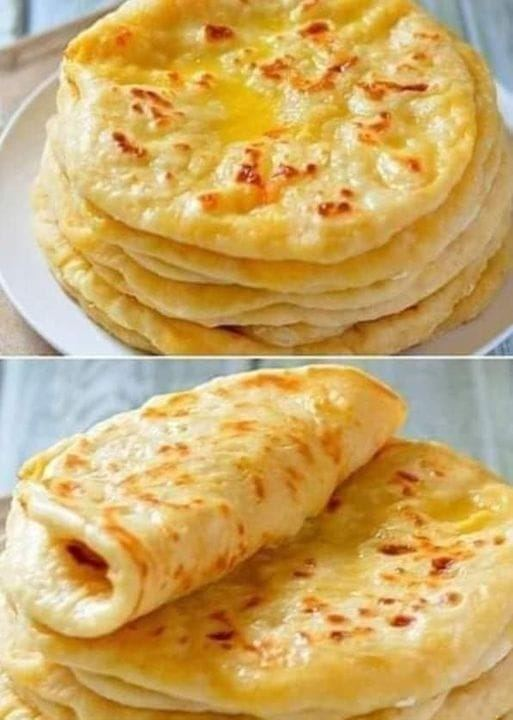Introduction
Keto Low-Carb Flatbread is a versatile, soft, and chewy alternative to traditional bread that fits perfectly into a ketogenic lifestyle. Whether you’re looking for a base for your favorite sandwich, a side for your meal, or a vehicle for dips, this flatbread is an excellent choice. It’s not only simple to prepare but also gluten-free, making it suitable for various dietary needs. In this guide, we will provide detailed instructions, measurements, and nutritional information to help you create the perfect flatbread.
Ingredients
Dry Ingredients
- 1 cup almond flour (finely ground)
- 1/4 cup coconut flour
- 1 teaspoon baking powder
- 1/2 teaspoon salt
- 1 teaspoon garlic powder (optional, for added flavor)
Wet Ingredients
- 1 large egg
- 1/4 cup warm water (adjust as needed)
- 2 tablespoons olive oil (or melted coconut oil)
- 1 teaspoon apple cider vinegar (for extra tenderness)
Optional Toppings
- Sesame seeds (for garnish)
- Herbs (such as oregano or rosemary, for flavor)
Equipment Needed
- Mixing bowls
- Whisk or fork
- Rolling pin
- Parchment paper
- Baking sheet
- Non-stick skillet or griddle

Instructions
Step 1: Preheat the Oven
- Preheat Your Oven: Begin by preheating your oven to 350°F (175°C). This temperature is ideal for baking the flatbread to achieve a soft and chewy texture.
Step 2: Mix the Dry Ingredients
- Combine Dry Ingredients: In a large mixing bowl, combine the almond flour, coconut flour, baking powder, salt, and garlic powder (if using). Whisk together until well combined to ensure there are no lumps.
Step 3: Mix the Wet Ingredients
- Prepare the Wet Mixture: In a separate bowl, whisk together the egg, warm water, olive oil, and apple cider vinegar. Make sure the mixture is well blended before proceeding.
Step 4: Combine Mixtures
- Mix Wet and Dry Ingredients: Gradually add the wet mixture to the dry ingredients, stirring continuously until a dough forms. The dough should be slightly sticky but manageable. If it’s too dry, add a bit more warm water, one tablespoon at a time.
Step 5: Rest the Dough
- Let the Dough Rest: Allow the dough to rest for about 5-10 minutes. This step helps the flours absorb the liquid, making the dough easier to handle.
Step 6: Prepare for Rolling
- Divide the Dough: After resting, divide the dough into 4 equal portions. Roll each portion into a ball and then flatten it slightly with your hands.
Step 7: Roll Out the Flatbreads
- Roll to Desired Thickness: Place a ball of dough between two sheets of parchment paper. Use a rolling pin to roll it out into a thin circle, about 1/4 inch thick. The thickness can be adjusted based on your preference, but keeping it consistent ensures even cooking.
Step 8: Preheat the Skillet
- Heat Your Skillet: In a non-stick skillet or griddle, heat it over medium-high heat. If desired, you can add a small amount of oil to the skillet to prevent sticking, although this is usually not necessary.
Step 9: Cook the Flatbreads
- Cook the First Flatbread: Carefully transfer the rolled-out flatbread to the heated skillet. Cook for about 2-3 minutes on each side, or until golden brown spots appear. Use a spatula to check the underside.
- Repeat Cooking: Remove the cooked flatbread from the skillet and place it on a plate. Cover it with a clean kitchen towel to keep it warm while you cook the remaining flatbreads.
Step 10: Store and Serve
- Keep Warm: Continue cooking the remaining portions of dough in the same manner. Stack the cooked flatbreads on the plate and keep them covered to retain warmth and softness.
- Serve: These flatbreads are best served warm. Use them for wraps, sandwiches, or alongside dips and spreads.
Step 11: Store Leftovers
- Refrigerate or Freeze: Store any leftovers in an airtight container in the refrigerator for up to 5 days. Alternatively, you can freeze them for up to a month. To reheat, simply warm in a skillet or microwave.
Step 12: Nutritional Information
- Nutritional Breakdown (Per Flatbread): This recipe makes about 4 flatbreads. Each flatbread contains approximately:
- Calories: 180
- Total Fat: 14g
- Saturated Fat: 1.5g
- Cholesterol: 30mg
- Sodium: 200mg
- Total Carbohydrates: 6g
- Dietary Fiber: 3g
- Net Carbohydrates: 3g
- Protein: 6g
Step 13: SmartPoints
- Weight Watchers Points: For those following the Weight Watchers program, each flatbread is approximately 4 SmartPoints. This makes it a great option for a low-carb meal plan.
Tips for Success
Choosing Ingredients
- Almond Flour: Make sure to use finely ground almond flour for the best texture. Coarser flours may yield a grainy flatbread.
- Coconut Flour: Coconut flour absorbs a lot of moisture, so it’s essential to follow the recipe measurements closely.
Cooking Techniques
- Don’t Overcook: Keep an eye on the flatbreads while cooking. Overcooking can lead to a tough texture. Aim for a golden brown finish.
- Even Thickness: Rolling the dough to an even thickness ensures that the flatbreads cook uniformly.
Serving Suggestions
- Versatile Use: These flatbreads can be used for various purposes, such as wraps, pizza bases, or served with soups and salads.
- Toppings and Fillings: Fill them with your favorite ingredients like grilled vegetables, avocado, or vegan cheese for a delicious meal.
Conclusion
Keto Low-Carb Flatbread is a delightful addition to your meal planning, offering a soft and chewy texture that satisfies your bread cravings without the carbs. Its versatility allows it to complement a variety of dishes, making it a must-try for anyone on a keto or low-carb diet. With this detailed guide, you’re well-equipped to create delicious flatbreads that can be enjoyed in numerous ways. So gather your ingredients, follow the steps, and enjoy the wonderful flavors of homemade keto flatbread!

